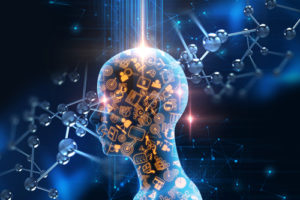Reference to artificial intelligence (AI) has become strategic in higher-ed discourse, joining the terms “big data” and “predictive modeling.” When I was introduced to AI in 2013 by a member of our design team, it captivated my imagination. Since then, as our data grew to proportions that were ripe for AI, I’ve become enthralled by its potential to enrich the accuracy and personalization that leads to better outcomes. That does not make me an expert.
If anything, it could make me equal to all out there who have wondered what these terms actually mean, how they matter to education, and where to draw the line between hype and results.
Defining the terms
Artificial intelligence is the broader concept of machines being able to carry out tasks in a way that we would consider “smart.”
Machine learning (ML) is a current application of AI based around the idea that we should really just be able to give machines access to data and let them learn for themselves (Bernard Marr, author, speaker).
Note: Neither definition implies the machine outsmarts or replaces its human team.
AI in healthcare
Like higher ed, healthcare systems are complex, tethered to random human behavior, constantly evolving, and looking to technology to help improve outcomes for all. I found the following healthcare example helpful for visualizing how AI makes it possible to take human expertise and replicate it at scale.
In a healthcare experiment, AI scientists worked with experts at diagnosing a certain type of lung cancer. Collectively, these teams converted expert knowledge into a set of rules and decision trees for reading a lung cancer X-ray and determining diagnosis. In the end, the machine “student” outperformed the very experts who designed its rules.
For some people this outcome seems obvious and acceptable. For others, the thought of relying on a machine diagnosis over a trusted doctor is not acceptable. The reason the machine outperforms the human, while following the same rules, is that the machine is free from bias, second-guessing, fatigue, or distraction. The AI machine becomes a critical member of the team—not a replacement.
Machine learning operates at a deeper level of AI. It involves uncovering rules that human effort may not ever uncover. In Marr’s definition of ML, the descriptor “let them learn for themselves” does not mean the computer develops a brain. What it means is that instructions and formulas can be programmed into the machine and it will process every possible iteration to deliver all findings for human interpretation.
AI in higher ed
We figured out how to gather data on which day-to-day campus interactions (including brick-and-mortar, online, and hybrid ecosystems) result in higher probabilities of success or thriving for each student. Consider each day-to-day interaction to pave a path, at the individual level. To personalize each path, we need to identify variables from the whole thriving data set that change patterns for success.
One way to do this is to hypothesize that a variable in the dataset might yield differences. For instance, a hypothesis could be that pathways to success are different for individuals with prior college compared to no prior college. Such a hypothesis can easily be tested by splitting the data set by this one variable and comparing the highest correlated thriving patterns for similarity or difference. When analysis indicates patterns are 90-percent unique in each group, then the variable is validated as a determining factor for creating personalized and adaptive guidance.
However, if we forego hypotheses and instead program the machine to replicate our validation process on each variable in the set, the machine will analyze all 80,000+ possible permutations and provide output for interpretation. Often, the output includes high-value variables we were unlikely to have hypothesized. ML allows for bottoms-up data intelligence and focused, actionable data to be extracted from a complex and large dataset.
This result is not limited to analyzing the student population. Most important, this same technique can be applied to finding out what on-the-ground experts are doing that may have value to the whole system. Much like the lung X-ray analogy, a group of experts provided rules and practices to the programming and the machine provided analytics about those with potential to scale.
AI’s lasting impact
We can also measure inspired ideas and expertise by administration, faculty, advisors, coaches, and others for correlation to individual success and evidence of performance at scale. We have found variables in the output that are low- to no-cost to test in control trials and then at scale. This combination of actionable data, extracted with precision, and affordable practices that work at scale is the powerful promise of AI to education. Realizing this promise depends on human intelligence and discipline around data practices.
With dialogue about AI and ML becoming pervasive, and often surrounded by excitement, it is important that everyone in this sector gain a basic understanding and language on this subject. Otherwise, this dialogue can become another hyperbole.
- Survey: More students want to go to graduate school - April 24, 2024
- Educause, AWS launch generative AI readiness assessment tool for higher ed - April 23, 2024
- A bungled FAFSA rollout threatens students’ college ambitions - April 19, 2024

